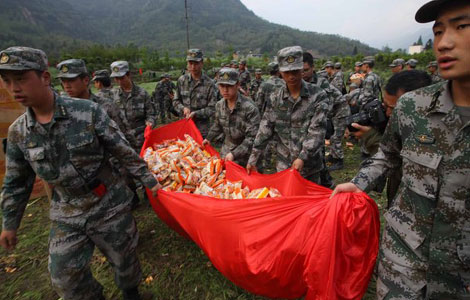Entrepreneurs and innovators find each other
Updated: 2012-11-23 12:46
By Hu Haidan in Boston (China Daily)
|
||||||||

The team behind a system for storing electricity in the chemical bonds of a water-based sodium-ion battery won the top prize in a Massachusetts Institute of Technology competition designed to spur collaboration with China.
Among other applications, the storage technology could enable the use of aqueous sodium-ion batteries to stabilize an electric utility's grid and as a cheaper, cleaner alternative to the lithium-ion or lead-acid batteries that now power most electric and hybrid vehicles.
Last weekend's second MIT-China Innovation and Entrepreneurship Forum, or MIT-Chief, also provided a platform for Chinese student innovators in the United States to swap ideas with entrepreneurs from China.
Over 20 members of the tech cognoscenti representing either country spoke on panels and shared advice with team members in the competition, called Pitch to China, as well as the audience.
Sodium Energy, a team of students advised by MIT professor and energy entrepreneur Yet-Ming Chiang, won the $10,000 prize for its Pitch to China entry.
The team stressed advantages of its storage system: speed (a sodium-ion battery can be 70 percent charged in 36 seconds); longevity (at least 1,500 cycles, about the maximum for a lithium-ion battery); "environmental friendliness" (no toxic elements such as lead, cobalt or fluorine, and no organic solvents); safety (use of water rather than a flammable solvent to conduct electricity); relatively low cost; and "energy density", or storage per unit of mass, that could make a sodium-ion battery as light and portable as the lead-acid variety.
Xiang Kai, a member of Sodium Energy, told China Daily that the innovation forum pushed his team to work harder than usual. The students turned their lab-based idea into a marketable plan for a product that could work and fill a consumer niche - one that could grow significantly.
The battery storage system was one of six student-team projects selected as finalists from about 160 entries in the Pitch to China portion of MIT-Chief. Besides technical details, the finalist teams had to present a business plan for the assembled Chinese entrepreneurs.
Projects were judged based on degree of innovation and the feasibility of bringing them to market in China.
"Any conversation about innovation and entrepreneurship depends not only on one person's effort at the most micro level, but also on the system in which they operate," said Kevin Steinberg, chief operating officer at World Economic Forum USA, who gave a speech at the forum. (The Forum is known for its annual gathering in Davos, Switzerland, of business, government and civl-society leaders.)
Another of the finalist teams, from Massachusetts nanotechnology startup Novarials Corp, produced a "ceramic paper" composite material for coating sodium-ion batteries.
The material, a rectangular sample of which was presented at the forum, can withstand very high temperatures while remaining bendable and flexible. It also has the potential to be used as a filtration or separation membrane in the chemical, petroleum, pharmaceutical and biotechnology industries, and for environmental remediation and protection.
"We appreciate the opportunity to show our products to the audience and to the experts," said Joe Wang, an engineer at Novarials.
During the three-day forum, participants and audience members spoke to invited tech experts, investors and entrepreneurs about venture capital, health care, alternative energy and other timely topics.
"We would like to create real opportunities for our audience, and we want to see real impact," said Zhang Xu, co-president of the forum and an MIT doctoral candidate in electrical engineering and computer science.
"Compared to other nations, economic growth in China is fast; the opportunities are huge. That's why I'm very confident for R&D in China going forward," said Yun Weijie, a senior adviser at California-based Northern Light Venture Capital, who served as a judge at the MIT forum.
Pointing out that big opportunities also involve big challenges, Yun said the biggest hurdle for innovators in China is identifying niches amid the hurly-burly of rapid growth.
Keeping research-and-development people in separate locations helps spur innovation, Victor Wang said in an interview. He's the president of Hanhai Investment Z-Park in San Jose, an incubator for US and Chinese tech firms that is backed by China's Hanhai Zhiye Investment Group and Zhongguancun Science Park.
"The Chinese team focuses on manufacturing, logistics and R&D assistance, while the American team focuses on core R&D and research," Wang explained.
With the two countries' economic success intertwined more than ever, innovation and collaboration carry the day, several experts told the MIT gathering.
"Cutting-edge technologies still come from the US, but the huge market is in China," said Northern Light's Yun. "If you come up with ideas and plans that leverage the two, it can give you a strong competitive advantage."
haidanhu12@chinadailyusa.com

 Relief reaches isolated village
Relief reaches isolated village
 Rainfall poses new threats to quake-hit region
Rainfall poses new threats to quake-hit region
 Funerals begin for Boston bombing victims
Funerals begin for Boston bombing victims
 Quake takeaway from China's Air Force
Quake takeaway from China's Air Force
 Obama celebrates young inventors at science fair
Obama celebrates young inventors at science fair
 Earth Day marked around the world
Earth Day marked around the world
 Volunteer team helping students find sense of normalcy
Volunteer team helping students find sense of normalcy
 Ethnic groups quick to join rescue efforts
Ethnic groups quick to join rescue efforts
Most Viewed
Editor's Picks

|

|

|

|

|

|
Today's Top News
Health new priority for quake zone
Xi meets US top military officer
Japan's boats driven out of Diaoyu
China mulls online shopping legislation
Bird flu death toll rises to 22
Putin appoints new ambassador to China
Japanese ships blocked from Diaoyu Islands
Inspired by Guan, more Chinese pick up golf
US Weekly

|

|







